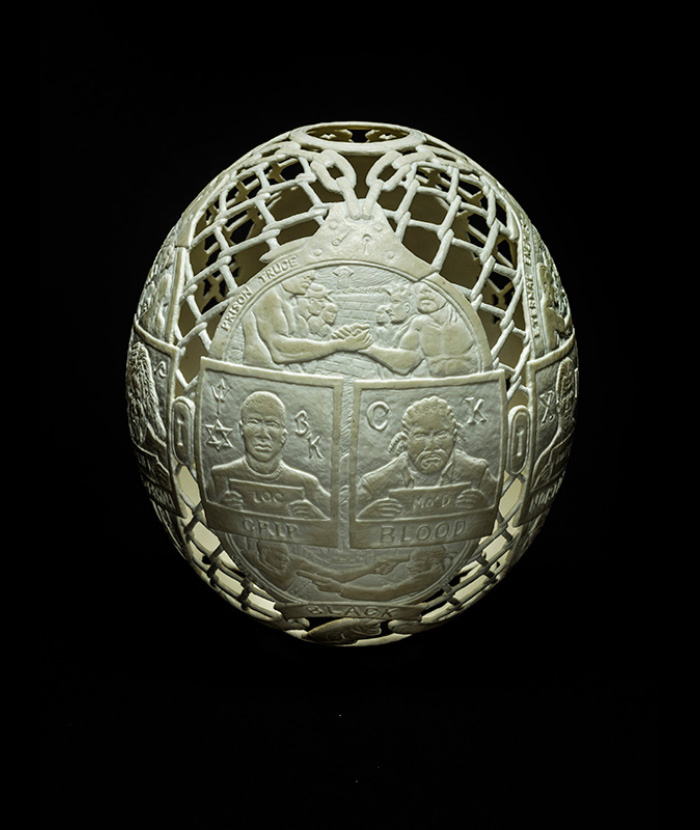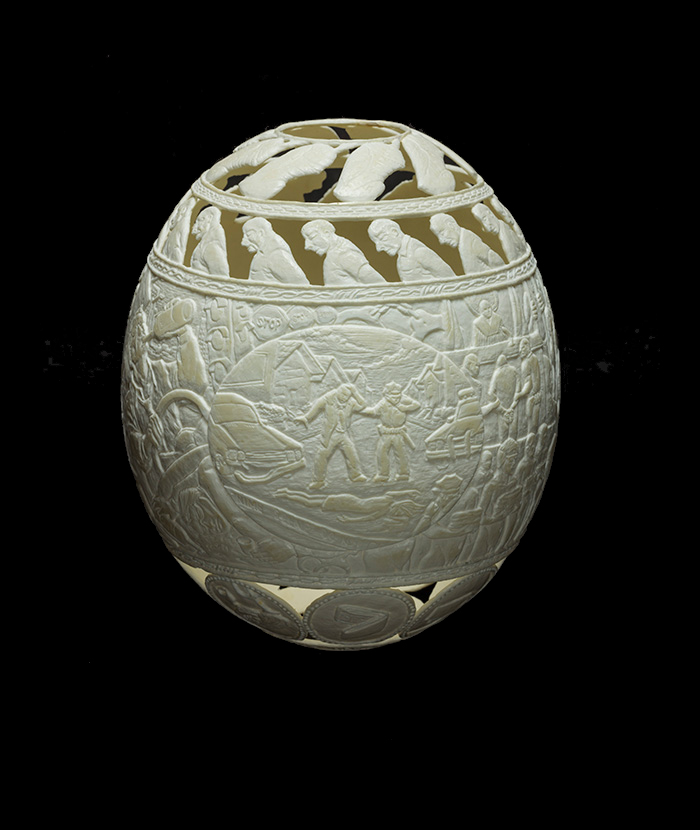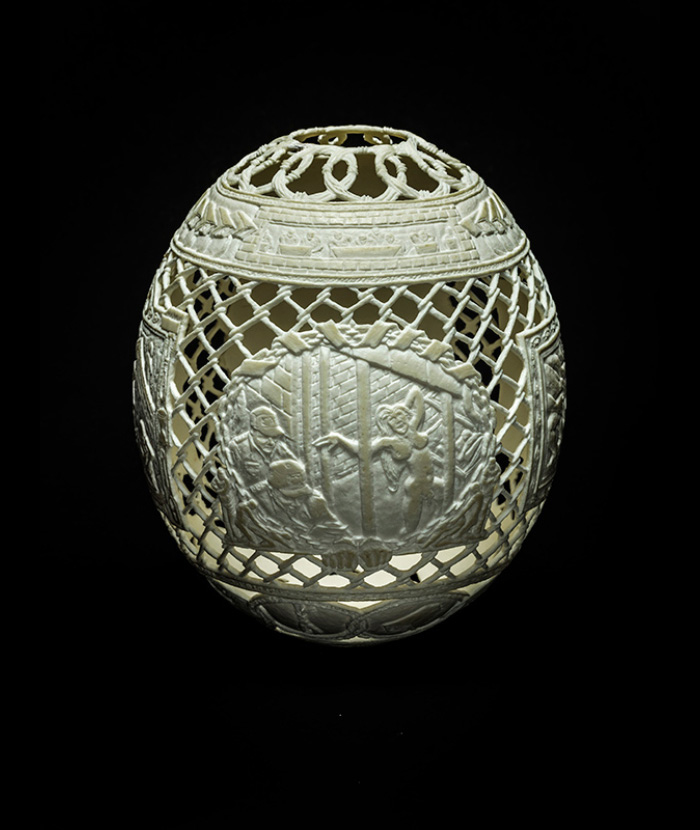Not many designers or engineers could deny that the egg is an amazing form. It’s shape is perfection and beautiful to look at. The egg of a chicken is just 0.3 mm. thick, yet is strong enough to withstand the laying and hatching process. The shell of an ostrich egg, in comparison, is about 2–3 mm. thick and, according to experts at the University of California, Santa Barbara, is strong enough for a human being to stand on.
Which brings us to Gil Batle. Gil is fifty-three years old and carves the detailed and breathtaking ostrich eggs you see here. Until recently, Batle's life has been fraught: in and out of five different California prisons over the past twenty years, a confined life where he witnessed and lived under inhumane conditions. Three of those prisons have names that would make anyone shudder: San Quentin, Chuckawalla, and Jamestown, known by prisoners as “Gladiator School,” for reasons I need not explain. All of these places are ruled by intimidation and force.
To stay alive in prison and in the good graces of these self-imposed societies, Gil turned to drawing family portraits from photographs beloging to fellow inmates. Posessing the ability to draw or tattoo can can insulate aprisoner somewhat from attacks, as long as one does not violate the unspoken inmate code. Batle also taught himself to tattoo other prisoners, clandestinely using crude needles and inks made from melted plastic.
According to Norman Brosterman, the man who discovered and recognized the talent of Mr. Batle, this turns out to be another one of those cases of being at the right place at the right time. One day, while perusing a trade show at Javits Convention Center, he came upon one of Gil Batle’s eggs, along with other things being displayed by Batle’s brother, who sells souvenirs for a living. That discovery changed everything for Gil Batle, who now lives in the Philippines. Today, a New York gallery sells his work for $14,000 each, and his first opening of over fifteen eggs was a sell out.
All of these eggs tell vivid stories Gil Batle remembers from his life in prison. Look closely and you will see that these ostrich eggs, once strong enough to hold the weight of a man, now recount the fragile memories of murder, intimidation, rape, and sadness.
You can see Gil Batle being interviewed by Jane Pauley here.
All descriptions below by the artist Gil Batle and have been edited for length.

51-50 Dreams, 2015
51-50 is a police code for “crazy person on the loose.” It's also a term inmates use to label the mentally ill convicts who have been medically cleared to roam in the general population in prison. Most inmates/convicts don’t mess with the 51-50s. I carved what I imagined what these guys dream about.

Chrysalis, 2014
The convicts that I chose to carve, I actually knew and interacted with, or I knew of them. “Knew of them” because of the racial politics in mingling with them in prison prevented me from actually meeting them. There are so many characters in the joint, so many with so many stories. Some of the names on my eggs were changed “to protect the guilty." On this egg, are:
Adobo is a preacher in San Quentin (SQ), a shot caller. On the yard, he is feared.
Hollywood is in Jamestown State Prison. Seen him on the yard, but never met him. Hollywood is his real prison name. On this egg, he is making Pruno (a prison wine). He makes the best.
Pradrino is always seen on the yard in San Quentin feeding the birds. Them birds always waited for him. You cannot approach him. He doesn’t carry a shank (prison knife). He just points his finger (as seen at the bottom of this egg) and things are taken care of.
Silent drew the best tattoos I ever laid eyes on—clean, bold work. I wrote on the egg: “Ink service by appt. only,” because his tattoos have been published in tattoo magazines through parolees. I have read that a person on the street who wanted a tattoo from him had to commit a felony to get one.
Mr. Peabody, I never met, but I saw this nerdy, little kid at Donavan State Prison playing chess with the most brutal looking convicts. Apparently he pays for protection by sending money to the family of the convicts via his cyber network on the streets.

Cicadia-Nymphs, 2014
I like the idea that the cicada nymph stays burrowed underground thirteen to seventeen years before it emerges to mate. It is unknown what takes place underground for all those years. I relate this idea to how civilians on the outside view inmates serving very long sentences on the inside. Folks on the outside don’t know what we do on the inside.

Gang Chart II, 2015
It is my understanding that most prisons in the US are not as racially segregated as California’s. During my incarceration in the California prison system, races for the most part did not mix. In the California Prison System, the four main races are segregated by cells: whites, blacks, Mexicans, and others. Although there are several more gangs other than the ones that I’ve carved here on this egg, I’ve selected to carve two convicts from within each who stood out to me the most, in mug shot form
(real names are rarely used in prison) along with the tattooed symbols I’ve seen during my incarceration.

Ghost Communication, 2014
Ghost communication is an unseen method that prisoners use to communicate, through toilet bowl plumbing, hand signals, coded letters and language, etc. The prisoners run the prison. Many prisoners have jobs in there such admin clerks, kitchen work, laundry, welding, etc. So passing weapons, drugs, and messages through the system was almost impossible to stop. San Quentin was like a small city. On one egg written in the handcuffs are the words. “The yard is too quiet.” This was an eerie sign that meant there will be a hit on a person or persons on the yard. The hit would be coordinated through Ghost Communication. Most of us knew of the hit prior to yard time ... except for the guards and the targeted prisoner(s) of course.

It’s Your Fault II, 2014
It begins with my father and most of the prisoners’ fathers. If you look closely at the father whipping the child, you’ll notice the child’s hair, sort of a Dennis the Menace cut and as you continue on the next panels to the right, you’ll see that same haircut on a certain character in each panel. It’s the same guy progressing on to prison. He gets whipped as a child, becomes the bully, and carries that behavior on to his own family. Soon after, he falls into crime and faces the police on the streets then eventually—the prison guards. The whipping/beating became a part of their lives. Sooner or later the beatings don’t hurt anymore and any punishment after that is futile. “Two hots and a cot.”

Jargon, 2014–15
The prison staff screens and censors all incoming and outgoing inmate mail. This is to prevent contraband (usually drugs hidden in stamp gum or between photos or greeting cards) from coming in and also to prevent any communications that would lead to illegal activity outside or within the prison walls. So prisoners with bad intentions would disguise their letters with poetry or jargon with hidden messages to get their message through.

Manslaughter, 2015
This is about a guy I met in Tracy State Prison. His name is Angel. He is half-Filipino and half white. He ran with us to avoid the white prison politics. He was serving, I believe, eight years for accidentally killing a woman while driving under the influence of alcohol. Vehicular Homicide: Manslaughter. He had no criminal record prior to the arrest—family man, a Christian and an alcoholic. When I got there, he seemed out of place, too nice of a guy. He got picked on a lot. Some of the Guamanians raped him. After the second attempt, he fought back and ended up receiving another three years for assault. He got his respect and was never picked on again.
Angel made friends with one of the Filipinos that didn’t get along with the Guamanians. That Filipino would be stepping over the lines if he spoke out against how Angel was being treated by the Guamanians since we were all Islanders. So, in private he made Angel a shank (prison made knife) for the next time it happened and to our surprise, Angel used it. The mystery was how the guards were at the right place at the right time. Charges were filed against Angel. No one ever found out who snitched.

Naked, 2015
There is nothing more humiliating and demeaning than the “cavity check.” This is done during your intake, before you enter the yard if a suspected riot is to occur, always after a visit, always during random cell raids, or some say whenever a guard just wants to mess with you. Also on this egg, there is a hand picking up a bar of soap. Some use the term “dropping the soap” as a joke. Well, until you've been naked in a shower room with a bunch of naked convicts and you drop your soap bar ... there is nothing funny about that. Don’t pick it up … leave it there! You bending down exposing your ass is like in invitation. Then, there are the transvestites. They don’t mind dropping the soap.

Reception New Fish, 2015
The images here depicts the process of the new inmate (fresh fish) entering prison and the standard set of supplies you are given when enter: a roll of toilet paper, comb, toothbrush, toothpaste, soap, and safety razor.

Sanctuary, 2014
This is about how most convicts are never free. It doesn’t matter if they are on the streets or in prison they are never free from the fear to survive. It’s only a matter of time when they will be back in the joint or on the streets. Both are terrifying. At the time, I too couldn’t find my sanctuary.

Tattoo, 2015
The motors used for the tattoo guns come from CD players, old cassette players, electric toothbrushes, clippers, etc. Some prisons crack down pretty hard on tattoo guns. In this case the motors are smuggled in—sometimes through the guards. It’s the ink-making process that I think is the most interesting. I would take a chess piece and melt it. Then use a paper bag or the bottom of a stainless table and trap the smoke/soot. Scrape off the soot and mix it with a lotion or shampoo (which contains disinfectants) and presto—tattoo ink.
